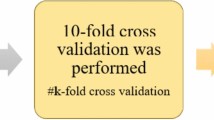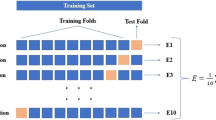Abstract
Chickpea is an important edible legume that can be grown in rain fed conditions. Image analysis and machine learning could be used for rapid and non-destructive determination of seed physical attributes and such techniques yield objective, accurate and reliable results. In this study, size, shape, and area attributes of 26 different chickpea cultivars were determined by image processing method, and color properties were determined by chromametric method, and machine learning algorithms (Multilayer Perceptron-MLP, Random Forest-RF, Support Vector Regression-SVR, and k-Nearest Neighbor-kNN, were used for mass prediction of chickpea seeds. Ilgaz and Çakır cultivars had the highest size and shape values, while İzmir and Sezenbey cultivars had the highest color attributes. Compactness (in horizontal orientation) had a positive correlation with the equivalent diameter (in vertical orientation) and elongation (in vertical orientation) (r = 0.99 for both parameters). Besides, a* had a high correlation with b* (r = 0.97). According to Euclidean distances, Akça–İnci and Damla–Işık cultivars were identified as the closest cultivars in terms of physical attributes. In PCA analysis, PC1 and PC2 explained 73.17% of the total variation. The PC1 included length, geometric mean diameter, volume and surface area, and the PC2 included roundness (in horizontal orientation), thickness, elongation (in horizontal orientation) and sphericity. RF and ML had successful results with the values of 0.8054 and 0.8043 for train-test split, and 0.8231 and 0.8142 for k-fold cross validation, respectively. Present findings revealed that texture image processing and machine learning could be used as an effective and inexpensive discrimination tool for chickpea seeds.





Similar content being viewed by others
References
Abbaspour-Gilandeh Y, Azizi A (2018) Identification of cracks in eggs shell using computer vision and hough transform Yuzuncu Yıl Univ. J Agric Sci 28:375–383
Abu-Salem FM, Abou-Arab EA (2011) Physico-chemical properties of tempeh produced from chickpea seeds. J Am Sci 7:107–118
Bacci L, Rapi B, Novaro P (2002) Durum wheat quality evaluation software. In World Congress of Computers in Agriculture and Natural Resources, Proceedings of the 2002 Conference (p. 49). American Society of Agricultural and Biological Engineers.
Durum wheat quality evaluation software world congress of computers in agriculture and natural resources Proceedings of the 2002 Conference
Cetin N, Yaman M, Karaman K, Demir B (2020) Determination of some physicomechanical and biochemical parameters of hazelnut (Corylus avellana L) cultivars. Turkish J Agric Forest 44(3):1–12
Chavan JK, Kadam SS, Salunkhe DK, Beuchat LR (1987) Biochemistry and technology of chickpea (Cicer arietinum L) seeds. Crit Rev Food Sci Nutr 25(2):107–158
Colton T (1974) Statistics in medicine. Little Brown and Company
Çetin N, Karaman K, Beyzi E, Sağlam C, Demirel B (2021) Comparative evaluation of some quality characteristics of sunfower oilseeds (Helianthus annuus L) through machine learning classifiers. Food Anal Methods 14:1666–1681
Çetin N (2022) Machine learning for varietal binary classification of soybean (Glycine max (l) merrill) seeds based on shape and size attributes. Food Anal Methods 15:2260–2273
de Camargo AC, Favero BT, Morzelle MC, Franchin M, Alvarez-Parrilla E, de la Rosa LA (2019) Is chickpea a potential substitute for soybean? Phenolic bioactives and potential health benefits. Int J Molec Sci 20:26–44
Demir B, Eski İ, Kuş ZA, Ercişli S (2017) Prediction of physical parameters of pumpkin seeds using neural network. Notulae Botan Horti Agrobot Cluj-Napoca 45(1):22–27
Demir B, Sayıncı B, Çetin N, Yaman M, Çömlek R, Aydın Y, Sütyemez M (2018) Elliptic Fourier based analysis and multivariate approaches for size and shape distinctions of walnut (Juglans regia L) cultivars. Grasas Aceites 69(4):e271
Demir B, Eski İ, Gürbüz F, Kuş ZA, Sesli Y, Ercişli S (2020) Prediction of walnut mass based on physical attributes by Artificial Neural Network (ANN). Erwerbs-Obstbau 62(1):47–56
Düzgüneş O, Kesici T, Kavuncu O, Gürbüz F (1987) Araştırma ve Deneme Metodları (İstatistik Metodları II). Ankara Üniv Ziraat Fak Yayınları: 1021 Ders Kitabı, 295 Ankara (In Turkish)
Eissa AHA, Mohamed MA, Moustafa H, Alghannam ARO (2010) Moisture dependent physical and mechanical properties of chickpea seeds. Int J Agric Biol Eng 3:80–93
Fathizadeh Z, Aboonajmi M, Hassan-Beygi SR (2021) Nondestructive methods for determining the firmness of apple fruit flesh. Inf Processing Agric 8:515–527
Food and Agriculture Organization of the United Nations (FAO) (2019) http://wwwfaoorg/faostat/en/#data/QC Accessed date: 06012022
George C, McGruder R, Torgerson K (2007) Determination of optimal surface area to volume ratio for thin-layer drying of breadfruit (Artocarpus altilis). Int J Serv Learn Eng 2:76–88
Gonzalez JPB, Ortiz F, A P Rodriguez CPP, (2017) Mass and volume estimation of passion fruit using digital images. IEEE Latin America Trans 15(2):275–282
Guidoti DT, Gonela A, Vidigal MCG, Conrado TV, Romani I (2018) Interrelationship between morphological agronomic and molecular characteristics in the analysis of common bean genetic diversity. Acta Scient Agron 40
Gürbüz F, Demi̇r B, Eski I, Kuş ZA, Yılmaz KU, İlikçioğlu E, Ercişli S (2018) Estimation of the weights of almond nuts based on physical properties through data mining. Notulae BotanHorti Agrobot Cluj-Napoca 46(2):579–584
Güzel D, Sayar S (2012) Effect of cooking methods on selected physicochemical and nutritional properties of barlotto bean chickpea faba bean and white kidney bean. J Food Sci Tech 49:89–95
Iqbal A, Ateeq N, Khalil IA, Perveen S, Saleemullah S (2006) Physicochemical characteristics and amino acid profile of chickpea cultivars grown in Pakistan. J Foodserv 17:94–101
Jogihalli P, Singh L, Kumar K, Sharanagat VS (2017) Physico-functional and antioxidant properties of sand-roasted chickpea (Cicer arietinum). Food Chem 237:1124–1132
Kara M, Sayinci B, Elkoca E, Öztürk İ, Özmen TB (2013) Seed size and shape analysis of registered common bean (Phaseolus vulgaris L) cultivars in Turkey using digital photography. J Agric Sci 19:219–234
Kibar H, Öztürk T, Temizel KE (2014) Effective engineering properties in the design of storage structures of postharvest dry bean grain. Acta Scient Agron 36:147–158
Kus ZA, Demir B, Eski I, Gurbuz F, Ercisli S (2017) Estimation of the colour properties of apples varieties using neural network. Erwerbs-Obstbau 59(4):291–299
Masoumi AA, Tabil L (2003) Physical properties of chickpea (C arietinum) cultivars. In 2003 ASAE Annual Meeting (p 1) American Soc Agric Biol Eng 1–14
McGuire RG (1992) Reporting of objective colour measurements. HortScience 27(12):1254–1255
Nikoobin M, Mirdavardoost F, Kashaninejad M, Soltani A (2009) Moisture-dependent physical properties of chickpea seeds. J Food Proc Eng 32:544–564
Omid M, Khojastehnazhand M, Tabatabaeefar A (2010) Estimating volume and mass of citrus fruits by image processing technique. J Food Eng 100(2):315–321
Ozturk I, Kara M (2009) Physico-chemical grain properties of new common bean cv‘Elkoca-05.’ Sci Res Essays 4:88–93
Parker JR (2001) Rank and response combination from confusion matrix data. Inform Fus 2(2):113–120
Rad MRN, Fanaei HR, Rad MRP (2015) Application of Artificial Neural Networks to predict the final fruit weight and random forest to select important variables in native population of melon (Cucumis melo L). Sci Hortic 181:108–112
Moosavi AA, Sepaskhah A (2012) Artificial neural networks for predicting unsaturated soil hydraulic characteristics at different applied tensions. Arch Agron Soil Sci 58(2):125–153
Naroui Rad MR, Ghalandarzehi A, Koohpaygani JA (2017) Predicting eggplant individual fruit weight using an artificial neural network. Int J Veg Sci 23(4):331–339
Ozaktan H (2021) Technological characteristics of chickpea (Cicer arietinum L.) cultivars grown under natural conditions. Turkish J Field Crops 26(2):235–243
Ropelewska E, Jankowski KJ (2019) Classification of the seeds of traditional and double-low cultivars of white mustard based on texture features. J Food Process Eng 42:13077
Ropelewska E (2020) The use of seed texture features for discriminating different cultivars of stored apples. J Stored Prod Res 88:101668
Ropelewska E, Sabanci K, Aslan MF, Azizi A (2022) A novel approach to the authentication of apricot seed cultivars using innovative models based on image texture parameters. Horticulturae 8:431
Sabanci K, Aslan MF, Ropelewska E, Unlersen MF (2021) A convolutional neural network-based comparative study for pepper seed classification: analysis of selected deep features with support vector machine. J Food Process Eng 25:13955
Saglam C, Cetin N (2022) Prediction of pistachio (Pistacia vera L) mass based on shape and size attributes by using machine learning algorithms. Food AnalMethods 15(3):739–750
Sastry DVSSR, Upadhyaya HD, Srinivas TR (2019) Variation for seed physical and hydration properties of chickpea (Cicer arietinum L) mini core collection and their relevance to conservation and utilization. Plant Gen Resour 17:311–324
Sayinci B, Ercisli S, Ozturk I, Eryilmaz Z, Demir B (2012) Determination of size and shape in the ‘Moro’ blood orange and ‘Valencia’ sweet orange cultivar and its mutants using image processing. Notulae Botan Horti Agrobot Cluj-Napoca 40:234–242
Sayıncı B, Kara M, Ercişli S, Duyar Ö, Ertürk Y (2015) Elliptic Fourier analysis for shape distinction of Turkish hazelnut cultivars. Erwerbs-Obstbau 57:1–11
Shabani A, Ghaffary KA, Sepaskhah AR, Kamgar-Haghighi AA (2017) Using the artificial neural network to estimate leaf area. Sci Hortic 216:103–110
Simonyan KJ, Yiljep YD, Oyatoyan OB, Bawa GS (2009) Effects of moisture content on some physical properties of Lablab purpureus (L) sweet seeds. Agric Eng Int CIGR Journal 11:1–13
Soares JDR, Pasqual M, Lacerda WS, Silva SO, Donato SLR (2013) Utilization of artificial neural networks in the prediction of the bunches’ weight in banana plants. Sci Hortic 155:24–29
Symons SJ, Van Schepdael L, Dexter JE (2003) Measurement of hard vitreous kernels in Durum wheat by machine vision. Cereal Chem 80:511–517
Varol IS, Yusuf Murat K, Irik HA, Kirnak H, Kaplan M (2020) Supplementary irrigations at different physiological growth stages of chickpea (Cicer arietinum L.) change grain nutritional composition. Food Chem 303:125402
Witten IH, Frank E (2005) Data mining: practical machine learning tools and techniques. Morgan Kaufmann Press, San Francisco
Funding
This study was supported by Turkish Scientific Research Council (TUBITAK) with the project number of 119O226.
Author information
Authors and Affiliations
Contributions
All the authors have accepted responsibility for the content of the entire manuscript.
Corresponding author
Ethics declarations
Conflict of interest
The authors are unaware of any conflict of interest or possible competition.
Consent to participate
Attached emails.
Consent for publication
Attached emails.
Additional information
Publisher's Note
Springer Nature remains neutral with regard to jurisdictional claims in published maps and institutional affiliations.
Rights and permissions
Springer Nature or its licensor (e.g. a society or other partner) holds exclusive rights to this article under a publishing agreement with the author(s) or other rightsholder(s); author self-archiving of the accepted manuscript version of this article is solely governed by the terms of such publishing agreement and applicable law.
About this article
Cite this article
Çetin, N., Ozaktan, H., Uzun, S. et al. Machine learning based mass prediction and discrimination of chickpea (Cicer arietinum L.) cultivars. Euphytica 219, 20 (2023). https://doi.org/10.1007/s10681-022-03150-5
Received:
Accepted:
Published:
DOI: https://doi.org/10.1007/s10681-022-03150-5




